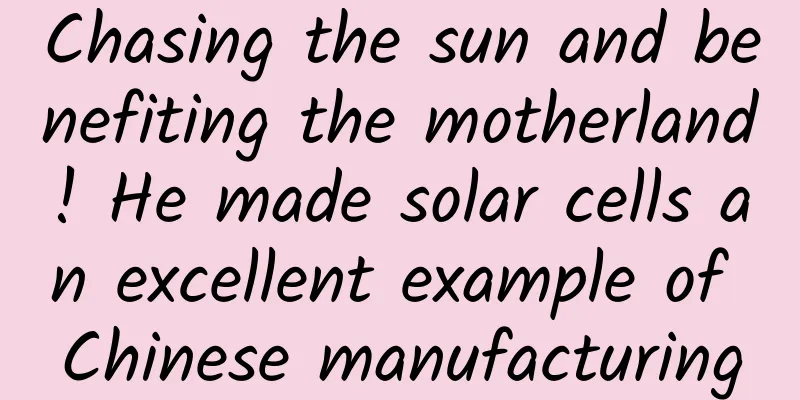Chasing the sun and benefiting the motherland! He made solar cells an excellent example of Chinese manufacturing

|
When non-renewable energy sources such as natural gas, coal, and oil are frequently in short supply, and energy issues are increasingly becoming a bottleneck restricting the economic development of the international community, more and more countries are beginning to implement the "Sunshine Plan" to develop solar energy resources and seek new impetus for economic development. Driven by the huge potential of the international photovoltaic market, solar cell manufacturing industries in various countries are competing to invest heavily and expand production in order to compete for a place. China has not shown weakness in this competition. With the continuous increase in national support and the continuous improvement of scientific research level, since the 1950s, my country has become a leader in the international solar cell industry, successfully surpassing Japan, Europe and other countries and regions, and becoming the world's largest country in solar cell production and application. ▲Mai Yaohua speaking at the Guangdong Provincial CPPCC meeting Mai Yaohua, who has been engaged in thin-film photovoltaic materials and solar cell research for many years, was very lucky. When he graduated with a doctorate, he just caught up with the explosive development of China's solar cells. With all his knowledge and deep affection for his motherland, he resolutely returned to China. From Hebei to Guangdong, from enterprises to universities, the experience in different roles and positions made Mai Yaohua's wings continue to grow. Determined to do his best for the development and growth of the country's solar cell industry, Mai Yaohua has a goal: to make Made in China truly the glory and pride of the Chinese people. Keep up with the latest academic trends "Be fair and capable, and keep improving" - the motto of Nankai University has inspired and enlightened generations of Nankai people with its broad spiritual power. Mai Yaohua's hard work, simplicity and pragmatism, enthusiasm, patriotism and dedication are the reflection of this spirit in him. Mai Yaohua is a true Nankai student. He completed his undergraduate, master's and doctoral studies at Nankai. Due to his outstanding performance, he was given the opportunity to study for a doctorate at the Photovoltaic Research Institute of the Jülich Research Center in Germany in 2002. This is a joint training program between Nankai and the Jülich Research Center in Germany. Here, Mai Yaohua launched an unremitting exploration of international cutting-edge hot issues in solar cells. There are two most commonly used methods for high-speed deposition of high-quality microcrystalline silicon. Plasma-enhanced chemical vapor deposition (PECVD) and hot-wire-assisted chemical vapor deposition (HWCVD) are very different in deposition process and deposition mechanism, so the microcrystalline silicon solar cells obtained by the two methods are also very different. It is found that the PECVD method has a very steep phase change zone and cannot obtain the high open circuit voltage corresponding to HWCVD. In order to study the impact of the structural evolution of the two methods on solar cells during the material growth process, Mai Yaohua used a new "Depth profile" method and found that the structural evolution of the material is closely related to parameters such as the seed layer and growth rate. Using the same high crystallization rate p-layer and lower i-layer growth rate, it is proved that the PECVD solar cell can obtain a uniform structure similar to the HWCVD method. Mai Yaohua also further compared the electrical and optical properties of the two materials and the differences in microstructure, and believed that the materials prepared by the two different methods are very similar, and there is no huge difference as people expected. Through the analysis of the device transport characteristics, he concluded that the reason for the above differences is that HWCVD solar cells have better interface characteristics, especially p/i interface characteristics. In order to verify this idea, he designed a clever experiment, using the advantages of HWCVD to improve the p/i interface of PECVD solar cells. As a result, PECVD has similar characteristics to HWCVD, and the open circuit voltage of the cell is 40mV higher than usual. The above results were presented orally at the 3rd International HWCVD Conference in Utrecht in 2004. Harv Mahan, the founder of HWCVD technology in the United States and the National Renewable Energy Laboratory (NREL), said in his overview report at the conference that "this is the most noteworthy article in the device category of this conference." These achievements ultimately made the efficiency of single-junction microcrystalline silicon solar cells reach 10.3%, which attracted attention with its high efficiency. After graduating with a Ph.D., Mai Yaohua chose the Debye Institute at Utrecht University in the Netherlands, where he conducted research on back-contact silicon-based heterojunction solar cells (HBC). Committed to improving product quality Mai Yaohua did not plan to work and live abroad for a long time. He believed that Chinese people should develop in China and only in the motherland can they develop better. In the process of constantly improving himself, he has been waiting for the opportunity to return to China. In October 2007, Ding Qiang, general manager of Tianwei Group, visited him and finally made his idea of returning to China come true. Tianwei Group is one of the earliest companies in China to enter the new energy field. Its main products are crystalline silicon raw materials and solar cells. In 2007, its production capacity was already leading the world, and many securities analysts called it the "leading new energy company." Since the second half of 2006, the price of polysilicon and monocrystalline silicon, the raw materials of crystalline silicon, has been rising, causing the production cost of solar cells to rise steadily, and European and American users have to look for solar cells made of new materials. Under such circumstances, thin-film solar cells, which were not favored in the past due to their low conversion efficiency, have regained favor and started to be applied in large-scale industry. At the same time, the transformation and innovation of technology and process are also accelerating, and the prospects are optimistic. In this context, Tianwei Group hoped to consolidate and deepen its position in the industry, and believed that thin-film batteries were one of the future development directions, so it began to recruit talents everywhere. Mai Yaohua recalled: "Mr. Ding came to Europe and met me and several other people. We exchanged ideas with each other. Mr. Ding talked about Tianwei's current situation and future plans. Tianwei's strength and future prospects made me yearn for it." Inspired by Ding Qiang, Mai Yaohua returned to China a few months later and joined Tianwei. In January 2008, Mai Yaohua, as one of the main founders, founded Baoding Tianwei Thin Film Photovoltaic Co., Ltd. together with Baoding Tianwei Baobian Electric Co., Ltd. Since the establishment of the company, Mai Yaohua has been responsible for the company's technology research and development and quality assurance. While applying foreign advanced technologies to the company, he also organized regular training for technical personnel to comprehensively improve the company's overall technical level. Mai Yaohua attaches great importance to product quality. When he went abroad, China did not have a well-known brand like Huawei. At that time, China was a world factory, producing two-thirds of the world's low-end products such as mice and keyboards. Because China's equipment manufacturing industry is underdeveloped, some people abroad often equate Made in China with poor product quality. "Once I went to play football and injured my foot. A colleague said that it was indeed a 'Made in China' foot. Of course, it was just a joke between colleagues, but the speaker was unintentional and the listener took it seriously." Mai Yaohua said, "From then on, I decided to return to China to make some of our own original, high-quality products." As the chief technology officer of Baoding Tianwei Thin Film Photovoltaic Co., Ltd., Mai Yaohua pays close attention to quality in the development of new processes and technologies. "Although high quality is based on a certain cost, we cannot require products to be 100% perfect, but what we need to do is to maximize the quality of products at the corresponding cost," said Mai Yaohua. Mai Yaohua's efforts were rewarded. In mid-2010, Tianwei Thin Film and the world's number one solar cell manufacturer, First Solar, met in Germany. First Solar not only has the largest production capacity of thin-film cells, but also has the largest production capacity of polycrystalline silicon cells. It is a true double champion and a leader in the industry. The solar cell engineering projects provided by Tianwei and First Solar were two rows of houses next to each other, forming a competition arena for each other to show their technical level. Half a year later, a third-party independent evaluation agency collected actual unit installed power generation data from users, and Tianwei Thin Film won. "Our power generation is 10% more than 'First Solar'. It is the benchmark in our industry!" Such a result was beyond Mai Yaohua's expectation: a little-known Chinese company surpassed the world's top players in energy conversion efficiency. Since then, Tianwei Thin Film, which has become famous in the industry, has been introduced to California by its American counterparts. Through American cooperative companies, it has provided 1.2MW of light-transmitting thin-film solar cells for 8 agricultural greenhouses in California. During his six years at Tianwei Film, Mai Yaohua worked hard to lead the company to achieve rapid growth. However, what seemed to be a smooth process to outsiders was not without difficulties and twists and turns in his eyes. Coming from a scientific research background, he had never worked in a company before, let alone served in a leadership position in a company. The different working environment required him to change his way of thinking. Mai Yaohua, who spent all his time in college thinking about improving conversion efficiency, now has to think about both improving efficiency and reducing costs in the company. In addition, dealing with interpersonal relationships is also a challenge for him. "Management is not about managing things, but managing people. To do things well, you have to solve many interpersonal problems. This is not only true in China, but also in the world," Mai Yaohua said. "In addition, the work done by the company is very comprehensive, and I have to learn a lot of basic work from scratch." Although this was a big challenge for Mai Yaohua at the time, when he left the industry and returned to academia, he found that it was this experience that made him understand so much. The six years working at Tianwei Thin Films was neither too long nor too short, and it was a period of time during which Mai Yaohua learned the most in his life. However, the speed of solar cell replacement forced him to return to academia, because technology was advancing and exploration was endless, and only by returning to academia could he fully challenge those cutting-edge issues. With a passion for exploring cutting-edge knowledge, Mai Yaohua returned to university. Striving towards industrialization Since 2013, as the director of the Photovoltaic Technology Research Center of Hebei University and the chief scientist of the Photovoltaic Technology Collaborative Innovation Center of Hebei Province, Mai Yaohua has led his team to challenge cutting-edge hot issues. In September 2016, Mai Yaohua moved from the north to the south and established the Jinan University New Energy Technology Research Institute and served as its dean, leading the team to strive for technological innovation and industrialization. ▲Mai Yaohua (right) directing the experimental work Playing the leading role of a leader, Mai Yaohua led the institute to gradually develop and grow. At present, the institute has a scientific research team of nearly 80 people, including 5 senior personnel, 9 deputy senior personnel, and more than 60 doctoral and master's students. The institute strives to build a domestic first-class and internationally renowned high-level new energy technology innovation and research and development platform, focusing on technological innovation and talent training, and promoting discipline construction and the development of new energy industry through cutting-edge technology research and development for industrialization, transformation of scientific research results and training of innovative talents. At present, the research direction of the institute is mainly new solar cells, lithium batteries and functional thin film materials and devices, with fixed asset investment of 40 million yuan, and undertakes major projects such as the "National Key R&D Program". "When the institute was established, I asked the team members not to do things that can only be published but can never be industrialized. We can cooperate with enterprises to transform technology, but we cannot replace the technical department of the enterprise. We can make very simple improvements and do advanced things." Mai Yaohua said. Although he has left the industry, Mai Yaohua often participates in industry activities. He is the deputy director of the Photovoltaic Committee of the China Renewable Energy Society and the vice chairman of the Guangdong Solar Energy Association. As a core member of the Photovoltaic Standardization Committee of the International Semiconductor Industry Association (China), he has presided over and participated in the formulation of more than ten national, industry and team standards. Mai Yaohua knows very well what the industry needs. With this positioning, Mai Yaohua led his team to conduct in-depth research on new perovskite solar cells and compound thin-film solar cells. Mai Yaohua introduced that as an outstanding representative of thin-film solar cells, new perovskite solar cells have developed rapidly in recent years and have shown great commercial value. Aiming at the development of new perovskite solar cells, with the goal of high efficiency and stability, the team has carried out innovative research based on perovskite thin films and devices. Focusing on perovskite solar cells, they have carried out three aspects of work, namely "solvent engineering", "component engineering" and "interface engineering", and have made a series of breakthroughs in the film formation dynamics of perovskite thin films, large-area perovskite solar cells and modules, perovskite indoor photovoltaic cells, perovskite/perovskite stacked cells, and perovskite/crystalline silicon stacked cells. It is worth mentioning that shortly after the establishment of the team, the members have successively undertaken a number of key R&D plan projects of the Ministry of Science and Technology, key projects of the National Natural Science Foundation of China, and projects of Guangdong Province and the city, published more than 100 papers in journals such as Energy & Environmental Science, Advanced Materials, and Advanced Energy Materials, and applied for more than 20 patents related to perovskite solar cells. In recent years, the institute has also made important breakthroughs in the transformation of scientific research results, and has achieved breakthroughs in the conversion efficiency of perovskite solar cells and modules seven times. To date, it still holds the records of large-size (>800cm2) rigid substrate perovskite photovoltaic module conversion efficiency, flexible substrate perovskite module conversion efficiency, and perovskite glass substrate and flexible substrate indoor photovoltaic cell conversion efficiency, with obvious technological advantages. Like the new perovskite solar cells, copper indium gallium selenide and cadmium telluride thin-film solar cells are also the most commercially valuable thin-film solar cells at present, with many advantages such as high conversion efficiency and stable performance. Among them, copper indium gallium selenide thin-film solar cells can be used for both rigid substrates such as glass and flexible substrates such as stainless steel and polyimide, with more application scenarios. Although copper indium gallium selenide and cadmium telluride thin-film solar cells have been industrialized, there is still a lack of core technologies with independent intellectual property rights in China. At the same time, these two batteries still face problems such as high cost and low efficiency in industrial production. In response to these core issues of industrialization, Mai Yaohua led the team to develop low-cost, high-efficiency and high-reliability compound thin-film solar cell preparation technology with independent intellectual property rights. At the same time, the team also carried out research on new compound thin-film solar cells such as copper-zinc-tin-sulfur and antimony selenide. At present, the team has made a series of breakthroughs in the field of compound thin-film solar cells. For example, the conversion efficiency of cadmium telluride batteries has reached 20.2%, which is the leading level in China; the efficiency of copper-zinc-tin-sulfur batteries has reached 12.5%; the conversion efficiency of antimony selenide batteries has reached 10.12%. Since the establishment of the institute in 2016, this direction has published more than 20 high-level papers in solar cell journals such as Nature Communications and Advanced Science. After just over a decade of development, the energy conversion efficiency of perovskite solar cells has increased from the initial 3.8% to the current 26.1%. However, while the efficiency of perovskite solar cells has steadily increased, the stability of perovskites to light, heat, water and oxygen has become a bottleneck in its industrialization process. Constructing 2D/3D heterojunction perovskites has been proven to be an effective strategy to improve the environmental stability of devices. In addition, the development of coating printing and large-area crystallization processes to achieve the preparation of large-area perovskite films and components is also a challenge that needs to be urgently addressed on the road to industrialization. "It has been seven years since the establishment of the institute, and we have entered the harvest stage. In the early stage, we did more basic research, studying how to make perovskite solar cells and sulfur-based thin-film solar cells more stable and how to achieve large-scale production. Now we are looking for a suitable application direction for these technologies." Mai Yaohua said. As an important project for the transformation of scientific and technological achievements of Jinan University, the team cooperated with Guangzhou Jinan University Science Park Management Co., Ltd. in August 2022 to establish Guangdong Mailuo Energy Technology Co., Ltd., and completed the angel round of financing in November 2022, with a total financing of more than 30 million yuan. This financing is used for the construction of a 10MW perovskite solar cell pilot line, and for the subsequent development of 1.2m×1.6m large-area perovskite batteries and the establishment of a 100MW production line for research and development preparation. On February 25, 2023, the pilot production line of perovskite photovoltaic modules built by Mailuo Energy achieved process connection, and the first large-area (30cm×30cm) perovskite photovoltaic module was officially launched. In June 2023, the conversion efficiency of 30cm×30cm perovskite photovoltaic modules reached 20.79%. In August, it once again broke the current reported conversion efficiency record to 21.50%, followed by the photoelectric conversion efficiency of the inverted structure flexible perovskite photovoltaic module reaching 21.09%. Make equipment with real core technology Mai Yaohua has been thinking about a question all along. In 2007, China was already the largest producer of solar cell modules. By 2013, China had become the country with the largest number of solar cell applications. But why are there still so many new companies emerging in China, while many old companies are constantly falling? What is the reason for such ups and downs? Through his experience in business and by establishing a research institute, Mai Yaohua discovered that China's photovoltaic industry still has many problems, the biggest of which is that most companies do not have their own core technology. Why can new enterprises beat old enterprises so quickly? Because the equipment is updated quickly, new enterprises spend huge amounts of money to buy new equipment, while the equipment of old enterprises has not yet been depreciated and cannot be updated, so they are naturally defeated by new enterprises. The real core technology is hidden in the equipment. Although my country has become the largest country in the production of solar cell components, in fact, China is still restricted by foreign countries, because a large number of original technologies come from foreign countries. We lack original technology is a fact that we have to face. When he returned to China, Mai Yaohua had already made up his mind to make products with real core technologies, and now many of the work he is doing is achieving this goal. He also wants to achieve this goal in equipment innovation. Currently, Mai Yaohua is working with enterprises to jointly explore and develop equipment for semiconductor companies. He said: "I believe that doing this is of great significance. Combining the advantages of all parties, I hope to make this domestic equipment into a top product. I also hope that more people will invest in it and do their best to make our contribution to China's equipment no longer relying on foreign countries and achieving true independence." Facing the wind and waves, Mai Yaohua firmly moves forward on the road of making Chinese manufacturing rise and take off. Expert Profile Mai Yaohua, professor at Jinan University, dean of the Institute of New Energy Technology, member of the Standing Committee of the 13th Guangdong Provincial Committee of the Chinese People's Political Consultative Conference, and national distinguished expert. He has been engaged in the research of new energy materials and devices for a long time, and his research directions include high-efficiency silicon-based solar cells, compound thin-film semiconductor materials and solar cells, perovskite solar cells and lithium-ion batteries. He has published more than 200 papers in journals such as Nature Communications, Energy Environ. Sci., Adv. Energ. Mat., J. Am. Chem. Soc., Nano Energy and Appl. Phys. Lett.; and obtained more than 50 authorized patents, including more than 30 invention patents. In 2010, he won the Hebei Province May Fourth Youth Medal, and in 2018, he won the "Overseas Chinese Contribution Award" of the All-China Federation of Returned Overseas Chinese. |
<<: What’s so special about weather events that have “numbered identities”?
>>: No need for surgery? This technology can "freeze" breast tumors to death!
Recommend
Apple responds to the poor battery life of the official version of iOS 15.4, netizens: Upgrading means planning to scrap it
Not long ago, Apple pushed the official version o...
Xingning SEO Training: Do you know the tools and methods for mining long-tail keywords?
If you have been optimizing keywords for a long t...
What are the essential elements for a perfect event planning program?
Do you hope that the event will become a hit? Tha...
What happens to foreign objects that accidentally enter the body?
Addendum 1: There is one more thing I didn’t ment...
Jintan SEO Training: Revealing the three reasons why keyword rankings cannot be improved
It is not uncommon to hear SEO practitioners refl...
The "cooked cakes" sold by Wu Dalang were not sesame cakes! But maybe... steamed buns?
Everyone knows that Wu Dalang from Qinghe County,...
How to prevent and treat “muscle deficiency”?
Author: Yuan Li, Beijing Longfu Hospital Reviewer...
Vehicle purchase tax exemption policy 2022: Which specific vehicles are subject to reduced purchase tax? Can I get a tax refund for items I’ve already purchased?
In order to promote the economic development of o...
Hongmeng OS internal test system experience exposed: the interface is obviously different from EMUI, simple and smooth
Last week, there was news that Hongmeng OS is bei...
Why did I have a negative view on WeChat Guangdiantong as soon as it was launched?
After much anticipation, WeChat finally launched ...
How to select images for information flow ads? Are there any tips?
As the title says, today we are going to introduc...
Wei Buhuo-A short video editing course that novices can learn in one go
To solve the common solutions to your daily editi...
Electric Technology Car News: It’s all about fun! How many performance cars do you know that are still only available with manual transmission in 2017?
With the continuous development of automobile tec...
How much does it cost to develop a supplement mini program in Meishan?
How much does it cost to be an agent for a supple...
Meizun's "Qianchuan System Course for Tik Tok Live Broadcast Operation" covers live broadcast operation planning, account creation, anchor training, Qianchuan delivery, etc.
Course Contents: Qihao Operation Practice Course....









